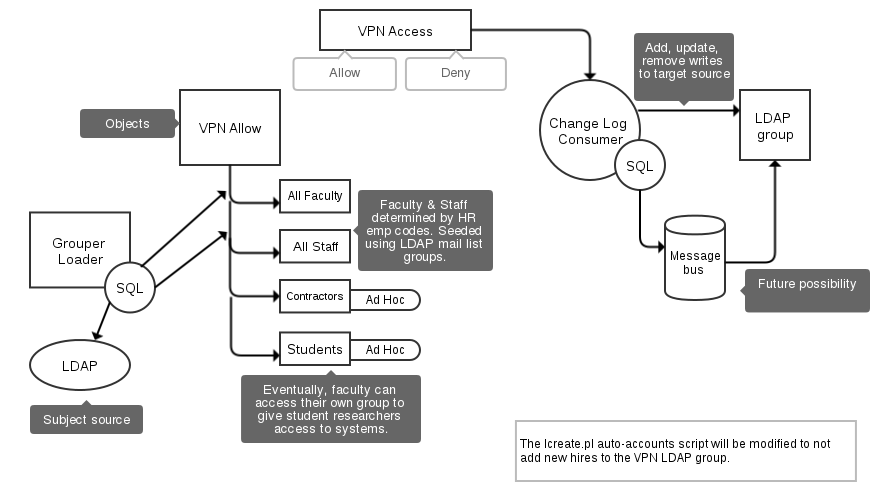Grouper Pilot Use Case: VPN access group population
Employees at Lafayette are able to access the College's network remotely via VPN. Some contractors and students are also granted ad-hoc access based on work requirements, faculty sponsorship, etc.
Pre-Grouper Access Management for VPN Authorization
VPN access was controlled via LDAP group membership. Employee membership in this group was handled automatically by custom provisioning and deprovisioning processes. Temporary employees, contractors, and students were not covered by these processes, and those requests were routed through the College's IAM team within ITS.
Leveraging Grouper and Its Benefits for VPN Access Management
Lafayette College's IAM team created data-driven groups in Grouper. Those groups are populated based on employee class codes that are maintained in Banner. Those reference groups are included in a composite group which in turn is used to provision the LDAP group used to control VPN access.
Two additional ad-hoc groups for contractors and students factored into the Grouper pilot use case. Those groups will eventually be managed by end users that are authorized to grant VPN access to those cohorts.
Nothing changed with respect to the way in which authorization to the VPN happened at a technical level. Grouper writes memberships to the VPN LDAP group which is still used for the control group. A major improvement that Grouper bring to the process is that decision makers now have direct control over VPN access rather than having to route requests through the IAM team.
Architecture
Grouper at Lafayette College is deployed as 2 components-- the Grouper UI and the Grouper API (aka Grouper Daemon). The Grouper UI is deployed in a manner consistent with other web-based deployments at Lafayette. The Grouper API components require elevated access to alter LDAP data, so they are deployed in a hardened network. Banner reference data is exported to LDAP on a nightly basis, and the Grouper Loader service is used to sync that data into Grouper on a nightly schedule. A separate instance of the Grouper Shell runs as a change log consumer. It monitors membership changes in Grouper and reports them to an LDAP provisioning process. The LDAP provisioning process accumulates membership changes and writes them in batches to the Lafayette College LDAP DIT at 30 second intervals.
Grouper Loader
The Grouper Loader runs continuously as a daemon process on College's Grouper API node. Several Grouper groups are linked to the College's LDAP DIT. The loader pulls memberships for these reference groups into Grouper nightly, as per the Quartz cron settings.
Change Log Consumer
The change log consumer was written using Bill Thomson's "Shell Wrappers for Grouper". If you are unfamiliar with the project, it leverages scripting languages that compile to JVM bytecode to wrap the Grouper Shell. For interactive sessions, this adds lots of extras found in modern REPLs like readline support and command history. It also allows non-Java experts to make good use of the Grouper API from more familiar programming environments (e.g. Groovy, Clojure, Jython). Lafayette's change log consumer runs as a daemon and tracks membership changes in Grouper. It sends these changes to a custom provisioning process that batches the changes. Batches are synced to the Lafayette LDAP DIT at 30 second intervals.
